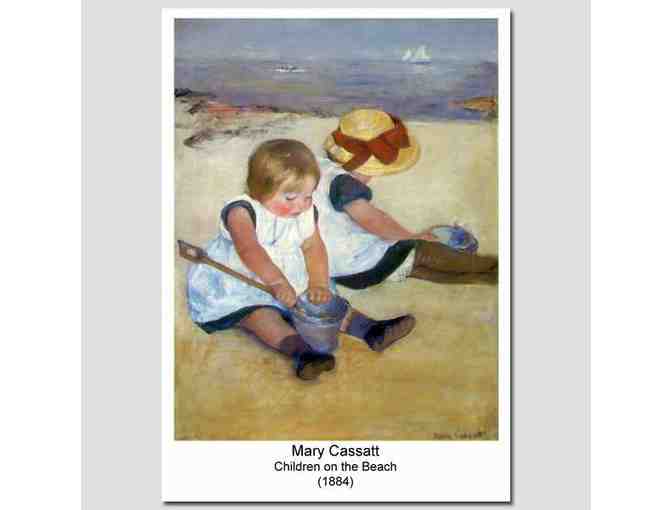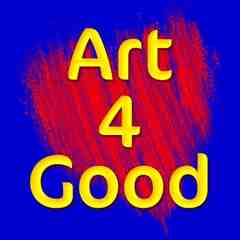EXTREME BARGAINS!
v-"Children on the Beach" by Mary Cassatt (1884)
- Item Number
- 2278
- Estimated Value
- 100 USD
- Opening Bid
- 10 USD
Item Description
"Children on the Beach" by Mary Cassatt (1884)
Master Artist Museum Print
Size: 11.7" x 16.5"
Status: Unframed
About the Artist
Born Mary Stevenson Cassatt on May 22, 1844, in Allegheny City, Pennsylvania. Mary Cassatt was the daughter of a well-to-do real estate and investment broker, and her upbringing reflected her family's high social standing. Her schooling prepared her to be a proper wife and mother and included such classes as homemaking, embroidery, music, sketching and painting. During the 1850s, the Cassatts took their children abroad to live in Europe for several years.
Though women of her day were discouraged from pursuing a career, Mary Cassatt enrolled in Philadelphia's Pennsylvania Academy of the Fine Arts at age 16. Not surprisingly, she found the male faculty and her fellow students to be patronizing and resentful of her attendance. Cassatt also became frustrated by the curriculum's slow pace and inadequate course offerings. She decided to leave the program and move to Europe where she could study the works of the Old Masters on her own, firsthand.
Despite her family's strong objections (her father declared he would rather see his daughter dead than living abroad as a "bohemian"), Mary Cassatt left for Paris in 1866. She began her study with private art lessons in the Louvre, where she would study and copy masterpieces. She continued to study and paint in relative obscurity until 1868, when one of her portraits was selected at the prestigious Paris Salon, an annual exhibition run by the French government. With her father's disapproving words echoing in her ears, Cassatt submitted the well-received painting under the name Mary Stevenson.
In 1870, soon after the outbreak of the Franco-Prussian War, Mary Cassatt reluctantly returned home to live with her parents. The artistic freedom she enjoyed while living abroad was immediately extinguished upon her return to the outskirts of Philadelphia. Not only did she have trouble finding proper supplies, but her father refused to pay for anything connected with her art. To raise funds, she tried to sell some of her paintings in New York, but to no avail. When she tried again to sell them through a dealer in Chicago, the paintings were tragically destroyed in a fire in 1871.
In the midst of these obstacles, Cassatt was contacted by the archbishop of Pittsburgh. He wanted to commission the artist to paint copies of two works by the Italian master Correggio. Cassattaccepted the assignment and left immediately for Europe, where the originals were on display in Parma, Italy. With the money she earned from the commission, she was able to resume her career in Europe. The Paris Salon accepted her paintings for exhibitions in 1872, 1873 and 1874, which helped secure her status as an established artist. She continued to study and paint in Spain, Belgium, and Rome, eventually settling permanently in Paris.
Though she felt indebted to the Salon for building her career, Mary Cassatt began to feel increasingly constrained by its inflexible guidelines. No longer concerned with what was fashionable or commercial, she began to experiment artistically. Her new work drew criticism for its bright colors and unflattering accuracy of its subjects. During this time, she drew courage from painter Edgar Degas, whose pastels inspired her to press on in her own direction. "I used to go and flatten my nose against that window and absorb all I could of his art," she once wrote to a friend. "It changed my life. I saw art then as I wanted to see it."
Mary Cassat died on June 14, 1926 at Château de Beaufresne, near Paris, and was buried in the family vault at Le Mesnil-Théribus, France
Item Special Note
SHIPPING AND HANDLING: $29.95
NOTE! SHIPPING AND HANDLING COSTS ARE INCLUDED IN THE BUY NOW PRICE!
Donated By:
ART+more4Good stores data...
Your support matters, so ART+more4Good would like to use your information to keep in touch about things that may matter to you. If you choose to hear from ART+more4Good, we may contact you in the future about our ongoing efforts.
Your privacy is important to us, so ART+more4Good will keep your personal data secure and ART+more4Good will not use it for marketing communications which you have not agreed to receive. At any time, you may withdraw consent by emailing Privacy@frontstream.com or by contacting our Privacy Officer. Please see our Privacy Policy found here PrivacyPolicy.


